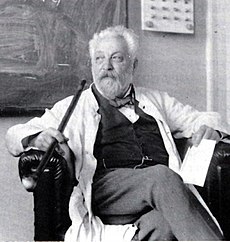Franz Serafin Exner
| Franz S. Exner | |
|---|---|

Franz Serafin Exner in 1915
|
|
| Born |
24 March 1849 Vienna, Austrian Empire |
| Died | 15 October 1926 (aged 77) Vienna, Austria |
| Residence | Austria |
| Nationality | Austrian |
| Alma mater | University of Vienna |
| Known for | Pioneering physics in Austria |
| Scientific career | |
| Fields | Physicist |
| Institutions | University of Vienna |
| Doctoral advisor | Viktor von Lang |
| Other academic advisors |
August Kundt Wilhelm Conrad Röntgen |
| Doctoral students |
Friedrich Hasenöhrl Marian Smoluchowski Stefan Meyer Lise Meitner Felix Ehrenhaft Karl Lark-Horovitz |
Franz Serafin Exner (24 March 1849 – 15 October 1926) was an Austrian physicist.
Exner comes from one of the most important university families of the Austrian-Hungarian empire. The same Exner family includes , , Sigmund Exner, and . Exner was the youngest of five children of parents and Charlotte Dusensy. His father Franz Serafin was, from 1831 to 1848, a professor for philosophy in Prague and from 1848 onwards was on the Board of Education in Vienna and an influential reformer of Austrian university education. He began his physics studies in Vienna in 1867 and attained a doctorate after an academic year in Zurich under August Kundt, also working with Wilhelm Conrad Röntgen, in the year 1871 in Vienna. The largest influence on his training was Viktor von Lang for his 1872 habilitation with a work entitled "On the Diffusion through Liquid Lamellas" ("Über die Diffusion durch Flüssigkeitslamellen"). In 1879 he took up an appointment as extraordinary professor and in 1891 he was renamed to full professor of the chemico-physical institute, 1902 to "second physical Institut", as a successor to Johann Josef Loschmidt, who had always worried about the "Exner children" as a close friend of family after the early death of his parents. When Exner was appointed 1908 as chancellor of the University of Vienna, he was at the pinnacle of his scientific activities.
Franz Serafin Exner can be described as a physicist with a strong vision, cultivating versatile and highly educated pupils. He was pioneer in numerous areas of modern physics. The early introduction of topics such as radioactivity, spectroscopy, electrochemistry (galvanic element), electricity in the atmosphere, and color theory in Austria can all be owed to Exner's doing. His most famous pupils included Marian Smoluchowski, a Viennese physicist of Polish descent, who discovered a theory independently of Albert Einstein and Friedrich Hasenöhrl for Brownian motion, and Victor Hess, whose attention for the exciting and extensive topic of atmospheric electricity and associated radioactivity was influenced by Franz Exner, together with , a pioneer in the study of the atmospheric electricity, and with Hess' discovery of "cosmic radiation" receiving the Nobel prize later, and the later Nobel prize winner Erwin Schroedinger, who began in 1911 as Exner's assistant, with "studies on the kinetics of dielectrics, melting point, pyro- and piezoelectricity" and finally Stefan Meyer. In the 1920s and 1930s most physics chairs were occupied by pupils of Exner: , Brno, later full professor in Prague; , Prague; , Graz; Marian Smoluchowski, Czernowitz, Krakau; , Vienna; , Innsbruck, Vienna; , extra full professor Vienna; Friedrich Hasenöhrl, Vienna; , , Vienna; Victor Conrad, Brünn, later USA; Felix Maria von Exner-Ewarten, Vienna; , Innsbruck; , Vienna; Felix Ehrenhaft, Vienna; , Brünn; Wilhelm Schmidt, Vienna; , Vienna; Victor Francis Hess, Graz, Innsbruck, New York; , Graz; , Vienna; Erwin Schrödinger, Jena, Leipzig, Zurich, Berlin, Graz, Dublin, Vienna; and Hans Thirring, Vienna.
...
Wikipedia
